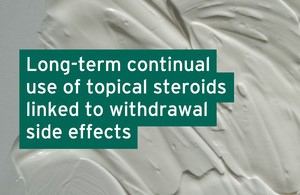諸外国におけるステロイド外用剤副作用への対応
- HOME
- 諸外国におけるステロイド外用剤副作用への対応
英語版
Cookies on GOV.UK
We use some essential cookies to make this website work.
We’d like to set additional cookies to understand how you use GOV.UK,remember your settings and improve government services.
We also use cookies set by other sites to help us deliver content from their services.
Accept additional cookiesReject additional cookiesView cookies
Navigation menu
- Topics
- Government activity
Search GOV.UK
1.Home
2.Vigilance, safety alerts and guidance
Press release
Long-term continual use of topical steroids linked to skin withdrawal side effects
The Medicines and Healthcare products Regulatory Agency (MHRA) is advising anyone experiencing skin redness or burning sensations after they have stopped using these creams or ointments to seek advice from their health professional before using these products again.
From:Medicines and Healthcare products Regulatory Agency
Published
15 September 2021

Patients using topical corticosteroid creams to treat conditions such as eczema or psoriasis are reminded to do so in accordance with advice from their healthcare professional, after a national review found that people using topical steroid for long-periods of time can suffer severe skin withdrawal symptoms.
Although this is very infrequent reaction, the Medicines and Healthcare products Regulatory Agency (MHRA) is advising anyone experiencing skin redness or burning sensations after they have stopped using these creams or ointments to seek advice from their health professional before using these products again.
Topical corticosteroids are medicines applied directly to the skin to treat conditions such as eczema or psoriasis. Patients can experience topical steroid withdrawal reactions after using these products at least daily for long periods of time. It is not unusual for skin conditions to flare up or return shortly after stopping topical corticosteroids. However, very infrequently, a severe type of topical steroid withdrawal reaction can occur, which may also be known as red skin syndrome or topical steroid addiction.
Signs of severe topical steroid withdrawal reactions include redness of the skin which can be a spectrum of pink to purple, or as darkening of the normal skin tone, depending on the skin tone of the individual. Other signs include burning or stinging, intense itching, peeling of the skin, or oozing open sores. These signs may occur days or weeks after stopping treatment and are known to occur after as little as 2 months of continuous treatment in children. Examples of topical steroids include beclometasone,betamethasone, clobetasol, hydrocortisone, mometasone, and triamcinolone.
Alison Cave, Chief Safety Officer of the MHRA said:
When used correctly, topical corticosteroids are a safe and effective treatment for conditions such as eczema and psoriasis.However, a withdrawal reaction following long term use of these products can lead to skin redness and a burning sensation worse than the original skin condition. These reactions can be hard to distinguish from the original skin condition.
Patients should follow their healthcare professional’s advice on where, how often and for how long to use topical corticosteroids. Patients experiencing symptoms after stopping their topical steroid treatment should contact a healthcare professional for guidance. We advise anyone experiencing potential withdrawal symptoms to speak to their healthcare professional before starting to use these products again. Suspected adverse side effects can be reported to us through the Yellow Card scheme.
Andrew Proctor, Chief Executive of National Eczema Society said:
Many children and adults rely on topical corticosteroids to manage eczema inflammation. As with other treatments though, they can have side-effects including after you stop using them. It’s very important people know how to use topical corticosteroids safely and effectively. We urge people who are affected to read the newly published patient safety leaflet and to speak to their doctor or other prescriber if they have questions and concerns.
To coincide with National Eczema Week the MHRA is publishing the outcome of a comprehensive national review, which included assessment of published clinical research, reported drug reactions and advice from skin charities and organisations. Product information for topical corticosteroids is being updated to include safety warnings on withdrawal reactions. We have developed a patient safety leaflet to support patients and health care professionals, which includes advice on how to reduce the risk of severe reactions.
Healthcare professionals should:
- prescribe the lowest potency of topical corticosteroid needed to effectively treat the skin disorder
- consider reducing the strength or frequency of application gradually if topical corticosteroids have been used for a prolonged time
- make sure patients know how to use it safely and effectively, especially on sensitive areas
- report all suspected adverse drug reactions to the Yellow Card scheme, including after discontinuation of topical corticosteroids
For further information on using topical corticosteroids safely please see the full Drug Safety Update article and Patient Safety Leaflet.
Media enquiries
News centre
MHRA
10 South Colonnade
London
E14 4PU
Email newscentre@mhra.gov.uk
During office hours: 020 3080 7651 (08:30 – 17:00)
Out of office hours: 07770 446 189 (17:00 – 08:30)
Office hours are Monday to Friday, 8:30am to 5pm. For real-time updates including the latest press releases and news statements,see our Twitter channel at https://twitter.com/mhragovuk
Share this page
日本語訳
イギリス政府 公式サイトより

医薬品、医療機器、血液の規制と安全性
警戒、安全警告およびガイダンス:詳細情報
プレスリリース 報道機関 公式発表
皮膚の離脱症状の副作用に関連する、ステロイド外用薬の長期継続使用
医薬品医療製品規制当局(MHRA)は、これらのクリームや軟膏の使用をやめた後に皮膚の赤みや灼熱感を経験している全ての患者さんに、これらの製品を再び使用する前に、医療専門家にアドバイスを求めることを勧告します。
医薬品&ヘルスケア製品規制当局発表より 2921年9月15日公開
全国的な調査 national review を実施し、ステロイド外用薬を長期間使用している患者が重度の皮膚離脱症状を患う可能性があることが判明した結果、湿疹や乾癬などのような症状を治療するためにステロイド外用剤を使用している患者は、医療専門家からのアドバイスに従って以下を再認識するよう忠告します。
これは非常にまれな反応ではありますが、医薬品医療製品規制当局(MHRA)は、これらのクリームや軟膏の使用を中止した後に、皮膚の赤みや灼熱感を経験している全ての患者に、これらの製品を再び使用する前に医療専門家にアドバイスを求めるよう助言します。
局所コルチコステロイド(ステロイド外用剤)は、湿疹や乾癬などの症状を治療するために皮膚に直接塗布される薬です。患者は、これらの製品を少なくとも毎日長期間使用した後、ステロイド外用薬離脱反応を経験する可能性があります。
局所コルチコステロイドの使用を中止した直後に、皮膚の炎症が急に悪化したり、短期間のうちにもとに戻ったりすることは珍しいことではありません。しかしながら、ごくまれに、重度のステロイド外用薬離脱反応が発生する可能性があります。これは、レッド・スキン・シンドロームまたはステロイド外用薬中毒としても知られています。
重度のステロイド外用薬離脱反応の兆候は、個人の肌の色に応じてピンクから紫の範囲の皮膚の発赤、あるいは通常の皮膚の色の黒ずみが含まれます。
その他の兆候としては、灼熱感や刺痛、激しいかゆみ、皮膚の剥離、開いた傷口からの浸出液などがあります。これらの兆候は、治療を中止してから数日または数週間後に発生する可能性があり、小児では早ければ2か月の継続的な治療の後に発生することが知られています。局所ステロイドの例としては、ベクロメタゾン、ベタメタゾン、クロベタゾール、ハイドロコルチゾン、モメタゾン、およびトリアムシノロンが含まれます。
MHRAの最高安全責任者であるAlison Caveは、次のように述べています。
局所コルチコステロイドは、正しく使用された場合、湿疹や乾癬などの症状の安全で効果的な治療法です。 しかしながら、これらの製品を長期間使用した後に続く離脱反応は、元の皮膚の症状よりも悪い、皮膚の赤みや灼熱感につながる可能性があります。これらの反応は、元の皮膚の疾患と区別するのが難しい場合があります。
患者は、局所コルチコステロイドをどこで、どのくらいの頻度で、どのくらいの期間使用するかについて、医療専門家のアドバイスに従う必要があります。 ステロイド外用薬の治療を中止した後に症状が出た患者は、医療専門家に連絡をとって相談してください。離脱症状の可能性がある患者は誰しもが、これらの製品を再び使用する前に、医療専門家に相談することを助言します。疑わしい有害な副作用は、イエローカードスキーム Yellow Card scheme を通じて私たちに報告することができます。
国立湿疹協会の最高経営責任者であるAndrew Proctorは、次のように述べています。
多くの子供と大人が、湿疹の炎症を管理するために局所コルチコステロイドに依存しています。 ただし、他の治療法と同様に、使用を中止した後など、副作用が生じる可能性があります。 ステロイド外用薬を安全かつ効果的に使用する方法を知っていることは非常に重要です。 症状のある方々には、新しく発行された患者安全リーフレットを読み、質問や懸念がある場合は医師または他の処方者に相談することを強く奨励します。
全国湿疹週間に合わせて、MHRAは、公開された臨床研究の評価、報告された薬物反応、および皮膚の慈善団体や組織からのアドバイスを含む、包括的な全国レビューの結果を公開しています。 局所コルチコステロイドの製品情報は、離脱反応に関する安全上の警告を含むように更新されています。 私たちは、患者と医療専門家をサポートするための患者安全リーフレットを作成しました。これには、重度の反応のリスクを減らす方法に関するアドバイスが含まれています。
医療専門家は次のことを行う必要があります。
- 皮膚障害を効果的に治療するために必要な局所コルチコステロイドは、最も効力の低いものを処方する。
- 局所コルチコステロイドが長期間使用され続けている場合は、薬の強度または塗布の頻度を徐々に減らすことを検討してください。
- 特に敏感な部位には、患者がそれを安全かつ効果的に使用する方法を知っていることを確認してください。
- 局所コルチコステロイドの使用中止後を含め、すべての疑わしい副作用をイエローカードスキームに報告してください。
局所コルチコステロイドを安全に使用するための詳細については、完全な医薬品安全性アップデートDrug Safety Updateの記事と患者安全性リーフレットPatient Safety Leafletを参照してください。
メディアのお問い合わせ
ニュースセンター
MHRA
10サウスコロネード
ロンドン
E14 4PU
メール newscentre@mhra.gov.uk
営業時間中:020 3080 7651(08:30-17:00)
営業時間外:07770 446 189(17:00-08:30)
営業時間は月曜日から金曜日の午前8時30分から午後5時までです。
最新のプレスリリースやニュースステートメントを含むリアルタイムの更新については、https://twitter.com/mhragovukのTwitterチャンネルを参照してください。
・原文はこちら
GOV. UK (Published 15 September 2021)
・上述のリーフレットはこちら。
Safety leaflet on topical corticosteroids and withdrawal reactions
